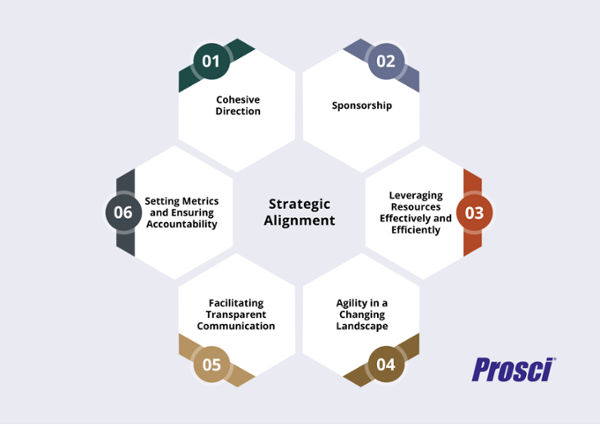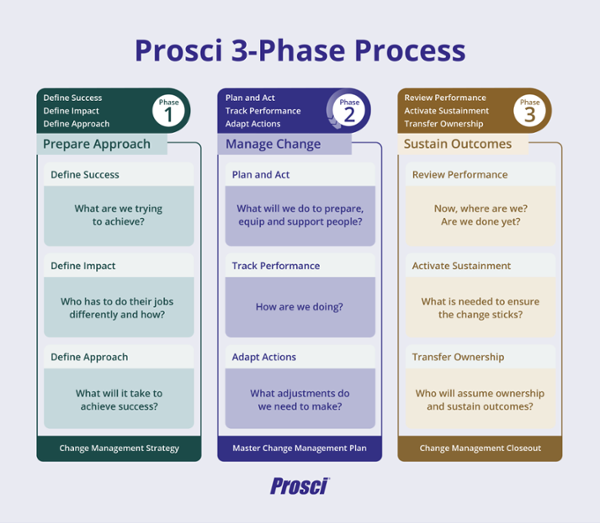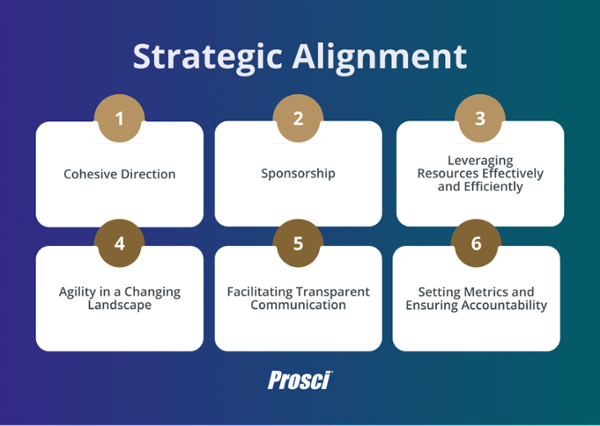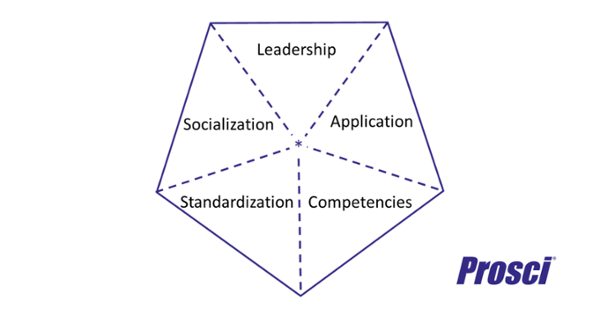Why Strategic Alignment is Essential to Enterprise Change Planning

8 Mins
Updated: April 18, 2024
Published: January 3, 2024

Change is inevitable and critical for forward progress. Strategic alignment is an intricate process that relies on cross-functional collaboration to help you make a successful change.
In this guide, we'll explore the concept of strategic alignment in change management, answer your frequently asked questions, provide expert insights, and explore why aligning your change initiatives with organizational goals keeps your team well-informed and prepared. By the end, you'll understand how to make strategic alignment work for your organization.
Grasp the Essential Role of Strategic Alignment
The essential role of strategic alignment lies in synchronizing an organization's overarching goals and strategies with its day-to-day operations and tactics. It bridges the gap between the vision set by leadership and the actions taken by various departments and teams. It creates a unified direction, ensuring every initiative and decision supports the broader organizational mission and objectives.
Strategic alignment is a universal principle, but its execution is distinct across various sectors, accommodating unique challenges and opportunities.
- In healthcare, aligning innovative patient care models with current health policies is key to ensuring compliance and enhancing patient outcomes.
- Utility companies might integrate sustainable practices within their long-term infrastructure planning, balancing ecological responsibility with growth and efficiency demands.
- Government entities find strategic alignment pivotal in aligning policy initiatives with public needs, ensuring governance is responsive and reflective of the community's priorities.
- Higher education focuses on updating curricula and technology to meet rapidly evolving educational trends and societal demands.
- The finance, banking and insurance sectors deal with the delicate balance of market dynamics, regulatory demands and customer expectations to ensure stability and trust.
Across these sectors, strategic alignment is critical to foster harmony between an organization's ambitions and practical strategies.
Explore the Nuances of Strategic Alignment
As we look into strategic alignment, we'll see how it can help every part of a company work better together and adapt to change.

Let's dive into strategic alignment and see how it helps all parts of a company focus on common goals and change together. Let’s begin by discussing building a vision where everyone knows where the company is headed.
One vision as a catalyst for unified action
Strategic alignment is about developing and adopting a clear vision everyone is on board with. This shared vision is pivotal in translating overarching goals into specific, actionable strategies and clear paths forward.
When every organization member understands and commits to these common goals, it results in a synergy that streamlines decision-making, project execution, and the ability to adapt collectively to market changes. This alignment transforms the shared vision into a dynamic force, driving the entire organization in a unified direction. It mitigates the risk of disjointed efforts and conflicting projects, ensuring that the organization responds cohesively to new opportunities and challenges, and moves as one towards its strategic objectives.
Sponsorship: The driving force behind strategic alignment
Drawing on extensive Prosci research on sponsorship, it's evident that sponsors—often senior leaders—are supporters and contributors in the strategic alignment process.
Their role is multifaceted:
- Resource allocation and advocacy – Sponsors provide essential resources and champion the alignment initiatives, ensuring the necessary tools and support are available for successful implementation. For example, sponsors might kick-start a leadership team with department heads. Their goal? To get everyone on the same page and working together seamlessly across the organization.
- Active engagement in organizational processes – Through proactive involvement in communication, decision-making and problem-solving, sponsors effectively bridge the crucial gap between high-level strategy and practical execution.
- Visible and consistent support – The presence and unwavering commitment of sponsors play a critical role in guiding teams and reinforcing the strategic direction set by the organization.
- Cultivating ownership and alignment – By demonstrating their commitment, sponsors inspire a sense of ownership and alignment across all organizational levels, ensuring everyone moves in unison towards shared goals.
This approach, underscored by Prosci research, highlights the indispensable role of effective sponsorship in driving and sustaining strategic alignment within an organization.
Leverage resources effectively and efficiently
Aligned strategies prioritize the judicious use of an organization's human, technological or fiscal assets.
By channeling resources into initiatives that resonate with the overarching organizational objectives, businesses can achieve cost prudence and back endeavors that promise substantial returns.
Agility as a facet of organizational change management
An organization's ability to adapt hinges significantly on strategic alignment, as Prosci insights on organizational agility underscored. This realization led us to explore change agility—since organizational change management capability prominently emerges as a crucial enabler of agility. When strategies align with core goals, an organization is equipped and agile in navigating market shifts and maintaining a competitive edge.
The importance of this agility cannot be overstated. Misaligned projects can sap agility, diverting resources and sponsorship from productive endeavors and hindering the organization's capacity to swiftly and effectively tackle new challenges and seize emerging opportunities. In essence, strategic alignment is not just a tool for organizational efficiency—it is vital in cultivating an agile, responsive, and ultimately successful organization.
Facilitating transparent communication
A cornerstone of strategic alignment is fostering open communication. With clear articulation of strategic goals, barriers between departments diminish, paving the way for a collaborative spirit where teams share insights and champion best practices, all in the interest of a common objective.
Strategic communication for effective alignment
Each industry faces distinct strategic alignment challenges requiring clear, actionable communication strategies.
Industry strategies look like this:
- Healthcare professionals should integrate patient privacy protocols into their communication processes to align with health policy changes while safeguarding patient confidentiality.
- Utility companies must develop clear messaging that explains the benefits of sustainable practices in infrastructure projects to a non-technical audience.
- Infrastructure leaders need to establish communication channels that facilitate the flow of information between contractors, government entities, and community groups to keep strategic projects on track.
- Government communicators should design public engagement initiatives that translate policy decisions into community benefits, aligning with citizens' expectations.
- Educational administrators in higher education are encouraged to continuously update communication methods to ensure academic changes are in step with job market developments.
- Financial service providers are advised to simplify financial updates and regulations in customer communications, aligning complex market information with client needs and understanding.
Adopting clear communication tailored to each industry is the answer to successful strategic alignment and operational unity.
Setting metrics and ensuring accountability
An aligned approach naturally lays the foundation for transparent success metrics. Clear objectives translate into precise key performance indicators (KPIs).
Setting clear benchmarks allows organizations to hold every team member accountable, focusing on achieving forward-looking goals.
Strategic alignment is the cornerstone of success across industries, uniting vision, communication, sponsorship and resource management. It transforms individual efforts into a cohesive force, driving organizations towards shared goals with agility. This unified approach is crucial for navigating industry complexities, turning strategic alignment from a concept into the driving force behind every successful organizational endeavor in today's dynamic business landscape.
Strategic Alignment Through the
Prosci 3-Phase Process
 The Prosci 3-Phase Process provides a structured and systematic approach to align an organization's strategies with its vision, goals and desired outcomes.
The Prosci 3-Phase Process provides a structured and systematic approach to align an organization's strategies with its vision, goals and desired outcomes.
This method ensures that initiatives across industries like healthcare, utilities, infrastructure, government, higher ed, finance/banking/insurance and others are strategically sound and effectively executed.
Among other things, the 3-Phase Process enables organizations to determine when they’re ready for change, understand the current and future state, and identify stakeholders and governance.

Phase 1 – Prepare Approach:
- Define Success – Establish clear success parameters, akin to a higher education institution setting goals aligned with job market trends.
- Define Impact – Assess the impact across the organization, like understanding the effects of new financial products on people in banking roles.
- Define Approach – Develop a tailored approach for managing changes, ensuring alignment with strategic objectives.
Phase 2 – Manage Change:
- Plan and Act – Implement change plans in infrastructure projects focusing on sustainable development.
- Track Performance – Monitor the performance of change initiatives against the set benchmarks.
- Adapt Actions – Modify strategies based on ongoing performance evaluations.
Phase 3 –Sustain Outcomes:
- Review Performance – Evaluate the overall effectiveness of the change initiatives.
- Activate Sustainment – Implement measures to ensure the longevity and adherence of the change.
- Transfer Ownership – Transition ownership to maintain and enhance the changes made.
By reframing strategic alignment within the Prosci 3-Phase Process context, organizations can ensure that their alignment efforts are comprehensive, structured, and conducive to achieving successful outcomes in their change management endeavors.
Strategic Intent in Change Management
Commit to strategic alignment in your change management efforts to drive success across various fields, from healthcare to finance, education, infrastructure and beyond.
This approach, supported by the Prosci Methodology, ensures that change initiatives are well-executed and ideally in tune with the unique strategic goals of each industry.
Here’s how:
1. Define your ambition
Make sure your new projects match your industry's main goals. For example, this could be using new healthcare technology to better patient care. In finance, it might be improving online banking to make customers happier. This way, everyone in your company knows the plan and works towards the same goals.
2. Gauge your maturity
Assessing your organization's current change management capabilities in the context of your industry's specific requirements is crucial.
For a utility company, this might mean evaluating how infrastructure resilience aligns with sustainable energy goals. This stage is vital for aligning your current state with the desired future state, ensuring that resources are strategically invested.
3. Dive deep into the Prosci ECM Framework
This map guides creating a change management strategy that aligns with your industry's unique challenges and opportunities. For instance, in higher education, this might involve aligning technological integration with evolving educational needs.
Each of the five key areas is tailored to support the strategic alignment of your organizational goals.
ECM Framework – Showing 5 Capability Areas

Every part of this plan is integral to ensuring new changes fit your industry's needs. Like in schools, where they update tech to keep up with new ways of teaching and learning.
4. Chart your unique path
Developing a tailored ECM framework means planning each capability area in alignment with your industry's strategic objectives.
Infrastructure could involve aligning long-term project goals with broader urban development plans, ensuring that every step taken is strategically focused.
5. Pinpoint your actions
This stage is about defining specific, strategically aligned actions within your sector.
In government, this could involve implementing new policy initiatives that align with public service goals and community needs. Here, strategic alignment ensures that the actions taken are helpful and all aimed at meeting the government sector's specific goals.

6. Craft your communication strategy
Effective communication in change management must resonate with your industry's specific needs and challenges.
Whether communicating about new healthcare technologies or financial services, your messages should align with and support your strategic goals, ensuring that all stakeholders are united in their understanding and efforts.
By focusing each step of the change management process on strategic alignment, organizations can ensure that their actions are practical and intricately aligned with their industry goals.
Expert Insights on Strategic Alignment
"The beauty of strategic alignment lies in its simplicity. By ensuring every change initiative ladders up to an organizational goal, you create a cohesive cascade to manage change."
—Michelle Haggerty, Chief Operating Officer and U.S. President, Prosci
"Organizations often mistake activity for productivity. Strategic alignment helps differentiate the two, ensuring that every action is purposeful and valuable."
—Ian Croft, Director of Advisory Services, Prosci
Frequently Asked Questions

1. What is an example of a strategic alignment?
Strategic alignment is when a company uses new tools to meet its main goals. For example, a clinic offers virtual doctor visits to help more patients.
In any industry, whether it's a law firm using online scheduling to save clients time or a retailer using an app to track orders, the idea is to choose tools that make reaching your big goals easier.
2. What are the challenges of strategic alignment?
Challenges of strategic alignment often involve getting different parts of a company to work together smoothly, updating plans when the market changes, ensuring everyone understands the company's main goals, and juggling day-to-day tasks with big-picture plans. To tackle these issues, companies must be flexible in planning and constantly focus on staying aligned with their goals.
3. What is the KPI for strategic alignment?
Key Performance Indicators (KPIs) in strategic alignment is a measure that tracks whether a company's everyday activities align with its main goals. For instance, a customer service business might look at customer satisfaction levels, while a tech company could count the number of new products it releases. These measures help ensure that every part of the company works toward the same objectives.
After discussing the theory behind strategic alignment and its challenges, let's briefly see how it works in practice:
Quick case study: Strategic tool rollout delay
A tech firm, aware of their staff's change fatigue, strategically delayed a new software launch, opting for a period of thorough training first.
The careful timing led to a smooth and successful adoption. This solution to a common problem illustrates the effective application of strategic alignment in change management.
The Strategic Alignment Advantage
The role of strategic alignment in today's business world is undeniable. It’s essential to healthcare's use of telemedicine or the utility industry's push for green practices, connecting big ideas with everyday work and turning challenges into chances to innovate and grow.
At Prosci, strategic alignment is essential for any company looking to manage change well and stay ahead. It helps ensure that all decisions support the company's main goals, leading to long-term success in an ever-changing world.
Ready to elevate your change management initiatives? Dive deeper and embark on a transformational journey with our Prosci Advisory Services team.


